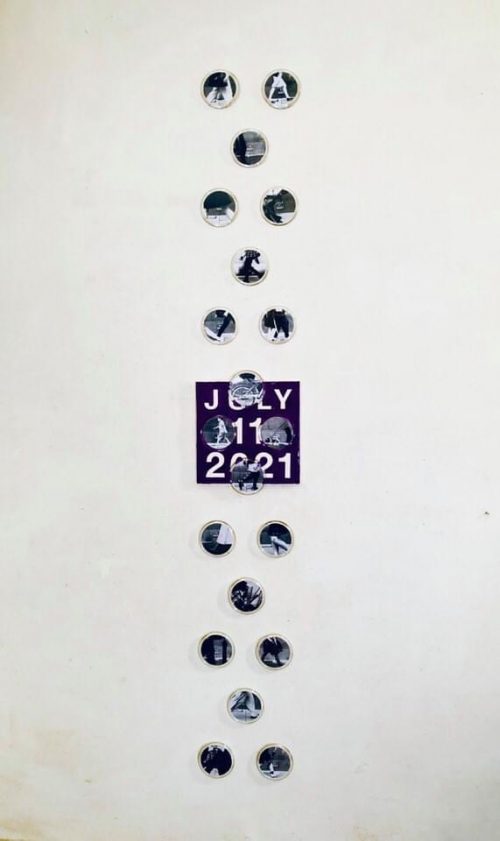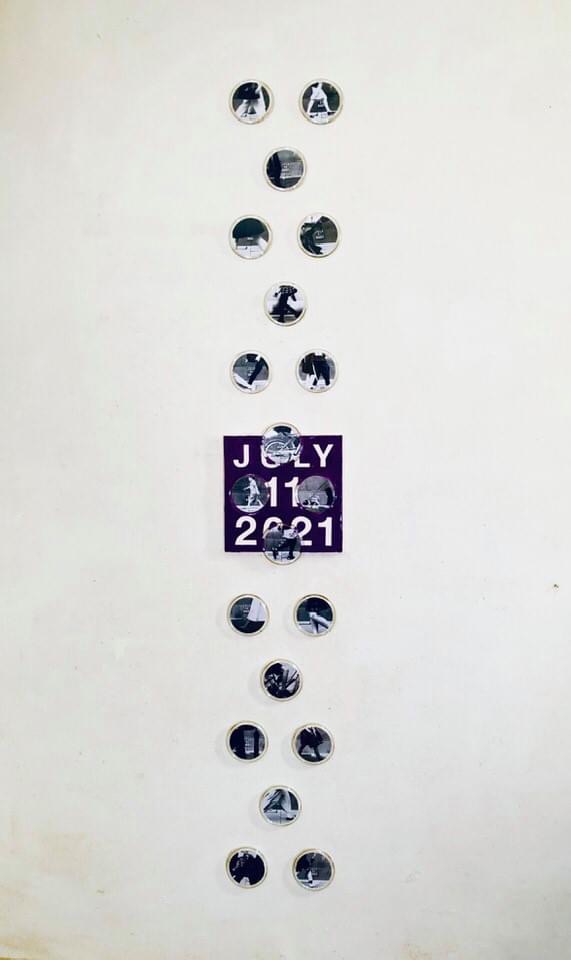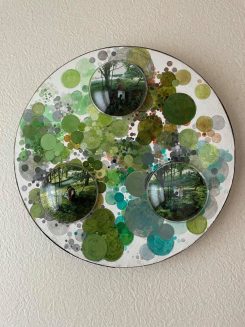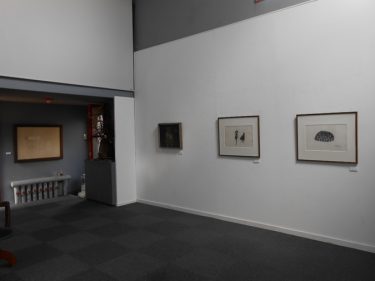作品を作ること、買うこと、そして残すこと
前回ご紹介した、現代アート作家の出口道吉さんのお話にもありましたが、作品を将来まで残すことは作家にとって課題である。(下の関連記事にリンクがあります。)
物質は物理的に朽ちていく。自然の摂理だ。人が衰え、亡くなるように、美術作品も普遍的なものではない。歴史的な作品は、人の手によって守られている。それは、評価され、価値あるものとして残っている。
評価や価値は、作家が生きているうちにつくとは限らない。そのため、出口さんは言うのである。
「作品を残すには、評価とマーケットが大事。マーケットがあれば人の手に渡る。1点でも多く売れれば、その人に大事にされて生き残る可能性が出てくる。さらに、いずれは評価の対象になる可能性もある。評価されると人は大事にするから。」
では、具体的に作品をどのように保つ工夫をしているか?
「写真は耐久性がない。それに、写真は生すぎる。コピーした方が丁度いい。レーザープリンタで写真をプリントし、紫外線カットの液体を塗る。写真でも試したが、インクが抜けてしまった。プリンタ、紙、紫外線カット、かなりテストを繰り返して今の形になった。」
アクリル板に関しても、自分で切り取ったり、専門業社に依頼したり、より良い方法を常に考えている。海外のアートフェアに持っていくには、コンパクトに出来る、誰でも設置できるやり方がより良いと配慮する。
特に出口さんの作品は、「記録する」がコンセプトだ。数多く残していければ、後世の人々にとって価値の高い作品となるだろう。
日本では、湿気や気候の変化があるため、紙や絵の具、鉄などにも条件が悪い。紙の上に何かを描く作品の場合、マットに接着し、額に入れて展示することが多い。その接着剤も変色の原因になる。湿気で塗料にカビが生えたり、逆に乾燥で絵具が剥がれることもある。暑さで溶けることも。紙自体も湿気を吸い変色し、キャンバスも朽ちることを避けられない。10年は大丈夫でも、30年50年後に変化なく保存するには、私たちの生きている環境において至難の業。
良い状態を長期間保つことは、作家にとっても、作品の所有者にとっても課題である。
1つ事実として
展示機会が多い作品は、良い状態が保たれている可能性が高い。
すどう美術館のコレクションである菅創吉の作品は、制作から50年以上のものばかりだ。額には入っているが、ガラスのない額がほとんどである。すどう美術館の館長はこれらの作品を本当によく展示する。そして、劣化しているようには見えない。作品の魅力そのままに輝いている。(くすんだ色使いなので、ピカピカしているわけではない。)底から湧くエネルギーのような、温かみのような輝きだ。
「壺中」に至っては、掛けてない時がない。館長、未だに壺にハマったままである。
作家にとって、いかに愛される作品を作り出すかも、評価と同様、いやそれ以上に大事なのかもしれない。
作品を持つことの付加価値
ここで、最初の話に戻る、流通により作品が人に渡る、守られる確率が上がる。これがマーケットの重要性なのだが、例えばそこに自分が介入したらどうだろう?
このブログでは、お家にお気に入りの作品を掛ける事がテーマだ。
そう、作品を購入し、家で楽しむ事は、それだけではない付加価値、つまり作品を守る、作家を守ることに繋がる!
私自身、そこまで考えて家に作品を掛けているわけではない。ただ、好きだから掛けているだけだ。出口さんの話を聞いたのがきっかけで気付かせてもらった。
作品を購入するときは、その作品が気に入り、家に掛けたい!と思うからだが、もう1つ、その作家を応援したい!という思いがある。
推しの俳優さんや歌手がいる方と同じ心理である。好きな俳優さんが出ている映画はチェックするし、好きなシンガーの新曲はいつも心待ちにしている。
もし、気に入った作品と出会った場合、家や職場など身近な所に掛けたいと思ったなら、実践してみてください。
アートのある暮らしが、自分を内側から豊かにするだけでなく、掛けているだけでも作品と作家を守っている。自分が持つ作品が将来評価され、後世の人々に愛される可能性へも広がりますね!
いい作品を後世に残していく過程に、家に絵を掛けるという方法で介入することも、1つのアートにかかわる付加価値なのではないでしょうか。
最後まで読んでいただきありがとうございました。
作品とのいい出会いを!
DEアートでした。
関連記事「作家 出口道吉 Artist Michiyoshi Deguchi」 ←この記事の中に「現代アートのアトリエからNo.4」があります。
協力 すどう美術館
作品の著作権は、作家にあります。複製、無断転載等はご遠慮ください。

【From one of a contemporary art studio. No.4】To create, to buy, and to preserve contemporary art.
As mentioned in the previous article by contemporary artist Michiyoshi Deguchi.
It is a challenge for artists to preserve their works into the future.
Materials physically decay. It is the natural order of things. Just as people decay and die, art works are not universal. A historical work of art is protected by human hands. They are valued and remain as valuable things.
Evaluation and value do not always come in the lifetime of the artist. That is why, as Mr. Deguchi puts it, “Evaluation and the market are important to preserve the work. If there is a market, the work will be sold. If you can sell even one piece of work, there is a chance that it will be cherished by the person and survive. Furthermore, there is a possibility that your work will eventually become the subject of evaluation. If you are appreciated, people will take good care of you.”
So, how exactly does he try to preserve his work? “Photographs are not durable. Besides, photographs are too raw. It’s better to make a copy for my works. I print my photos on a laser printer and apply a UV blocking liquid. I tried this with my photos, but the ink came out. The printer, paper, and UV protection were all tested and tested again and again until the current form was achieved.” As for the acrylic sheets, he is always thinking of better ways to cut them, either by cutting them out himself or by hiring a specialized company. In order to take his works to overseas art fairs, he considers the best way to make them compact and easy for anyone to install. The concept of Ms. Deguchi’s work in particular is to “record. If we can preserve many of his works, they will be of great value to future generations.
In Japan, conditions are not good for paper, paint, and steel because of the humidity and climate changes. When a work of art depicts something on paper, it is often glued to a mat and framed for display. The glue can also cause discoloration. Moisture can cause mold to grow on the paint, and drying can cause the paint to peel off. It can also melt in the heat. The paper itself absorbs moisture and discolors, and the canvas inevitably decays. It may be fine for 10 years, but it is difficult to preserve it unchanged for 30 or 50 years. It is extremely difficult in our living environment to keep them unchanged. Maintaining a good condition for a long time is a challenge for both the artist and the owner of the work.
As one fact.
Works that are frequently exhibited are more likely to be in good condition. The works by Sohkichi Suga in the collection of Gallery Sudoh are all more than 50 years old since they were created. Most of them are framed, but without glass. The director of Gallery Sudoh displays these works really well. They don’t look like they are deteriorating. They shine with the charm of the work. (They are not shiny because of the dull color scheme.)
It has a warm glow, like an energy that comes from the bottom. There is no time when Gallery Sudoh director Mr.Sudh doesn’t hang “Kochu” on. He is still stuck in the “Tsubo”.
For an artist, how to create a work that is loved is as important as, or perhaps even more important than, its reputation.
The Added Value of Owning a Work of Art
This brings us back to the first point.
Distribution increases the probability that the work will be passed on and protected by people. This is the importance of the market. So, for example, what if you were involved in that? The theme of this blog is to hang your favorite artwork in your home. Yes, buying a piece of art and enjoying it at home is more than just an added value, it’s about protecting the piece, protecting the artist! I myself don’t think that much about hanging artworks in my house. I just hang them because I like them. Listening to Mr. Deguchi’s talk made me realize this.
When I buy a piece of art, I like it and want to hang it in my house! Another reason is that I want to support the artist! It is the same psychology as those who have a favorite actor or singer. I check out the movies that my favorite actors are in, and I always look forward to the new songs of my favorite singers.
If you come across a piece of art you like and want to hang it in a familiar place, such as your home or office, practice it. Living with art not only enriches you from the inside out, but even just hanging it up protects the work and the artist.
It also opens up the possibility that your work will be appreciated in the future and loved by future generations! I think that intervening in the process of preserving good works of art for future generations by hanging pictures in houses is one of the added values involved in art.
Thank you for reading to the end.
Have a nice encounter with artwork!
This was DE art.
Related Articles▶「作家 出口道吉 Artist Michiyoshi Deguchi」 ←You can find “From one of contemporary art studio.No.4” in this article.
Cooperation Gallery SUDOH
The copyright of the work is held by the artist. Please do not reproduce or reprint without permission.


